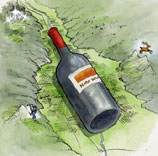
 Coombsville is bound by the Napa River to the west and the rim of the Vaca Range on the east and is one of the most southern sub appellations in Napa Valley. The altitudes range from near sea level at the western edge of the city of Napa, to about 1,900 feet around Mount George in the north.
Coombsville is distinguished by its soils, geography and climate, which differ distinctly from its adjoining regions. The Coombsville soils are dominated by the volcanic rhyolitic tuff — sedimentary rock and lava flows —of the Vaca Range on the eastern side of the Napa Valley. Located in the wide alluvial deposits created by the wearing down of the hillsides the Coombsville soils contain abundant rock, gravel and, in some areas, are layered with volcanic ash deposits from Mount George.
Proximity to the San Francisco Bay system, most notably San Pablo Bay, contribute to the temperate climate of Coombsville. Cooling effects of marine air and fog occur almost daily during the growing season, arriving earlier and lingering longer than in the more northern regions of Napa Valley. Temperatures are less extreme during the winter frost season. Bud break is often sooner and harvest is usually later, leading to a longer growing season.
As with much of Napa Valley, Bordeaux varietals are widely planted along with Syrah, Pinot Noir and Chardonnay. It has been noted by some that Cabernet Sauvignon clone 337 is well suited to the Coombsville terrior
Coombsville is bound by the Napa River to the west and the rim of the Vaca Range on the east and is one of the most southern sub appellations in Napa Valley. The altitudes range from near sea level at the western edge of the city of Napa, to about 1,900 feet around Mount George in the north.
Coombsville is distinguished by its soils, geography and climate, which differ distinctly from its adjoining regions. The Coombsville soils are dominated by the volcanic rhyolitic tuff — sedimentary rock and lava flows —of the Vaca Range on the eastern side of the Napa Valley. Located in the wide alluvial deposits created by the wearing down of the hillsides the Coombsville soils contain abundant rock, gravel and, in some areas, are layered with volcanic ash deposits from Mount George.
Proximity to the San Francisco Bay system, most notably San Pablo Bay, contribute to the temperate climate of Coombsville. Cooling effects of marine air and fog occur almost daily during the growing season, arriving earlier and lingering longer than in the more northern regions of Napa Valley. Temperatures are less extreme during the winter frost season. Bud break is often sooner and harvest is usually later, leading to a longer growing season.
As with much of Napa Valley, Bordeaux varietals are widely planted along with Syrah, Pinot Noir and Chardonnay. It has been noted by some that Cabernet Sauvignon clone 337 is well suited to the Coombsville terrior
|
|
Current Feature
In the southern Blue Ridge Mountains of North Carolina and Georgia vineyards are small and few, yet the establishment of the Upper Hiwassee Highlands could bring much more.
[>] continue
Related Features
Alive & Well here

Cabernet Sauvignon:
All hail the King! But a king doth not a gentleman make. A temperamental prince in youth, you’re
[>] continue
Correspondent
Barbara Trigg
is the Regional Correspondent for Coombsville.
